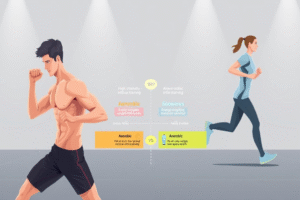Walking is one of the simplest and most accessible ways to lose weight and improve your overall health. Unlike intense workouts that require specialized equipment or a gym membership, walking is free, easy to do, and can be done almost anywhere. Whether you’re a beginner or looking to enhance your current routine, creating a structured walking plan can help you stay focused and motivated as you work towards your weight loss goals.
In this article, we’ll guide you through the steps to create an effective walking plan that will not only help you lose weight but also boost your fitness, mood, and energy levels. From setting realistic goals to choosing the right intensity, we’ll show you how to make walking a fun and sustainable part of your weight loss journey.
Table of Contents
Why Walking Exercises for Weight Loss Work
To lose weight, many people look for intense and intense workouts that promise fast results. But one of the easiest and most effective ways to lose pounds is through walking exercises. Walking is a low-impact activity that not only helps you lose weight, but also provides you with many other health benefits. In this post, we’ll explore exactly why walking exercises are so effective for weight loss and how you can incorporate them into your workout routine to achieve your goals
1. Walking Helps Burn Calories
The primary way to lose weight is by burning more calories than you consume, and walking exercises are one of the easiest ways to achieve that calorie deficit. Whether you\’re walking at a brisk pace or incorporating power walking, walking naturally burns calories.
- How it works: The number of calories burned depends on your walking speed, distance, and body weight. On average, walking at a moderate pace of 3-4 miles per hour can help you burn between 200-300 calories per hour. This is a significant calorie burn that can add up over time, especially if you walk regularly.
2. Walking Increases Your Metabolism
One of the key factors in losing weight is maintaining a high metabolic rate. Walking exercises help boost your metabolism, which means your body continues to burn calories even after you finish your walk.
- How it works: Walking at a brisk pace or incorporating more challenging walking exercises like uphill walking or interval walking can increase your heart rate. This helps enhance your metabolism, encouraging your body to burn fat even when you\’re not exercising. The more consistent you are with your walking routine, the greater the long-term effects on your metabolism.
3. Walking Is Low Impact and Sustainable
Unlike strenuous exercises like running or cycling, walking exercises are less impactful and less straining on the joints. This makes walking an excellent option for people of all ages and fitness levels. Whether you’re new to the gym or recovering from an injury, walking allows you to stay active without the risk of injury that often comes with more strenuous activities
- How it works: The low-impact nature of walking means you can sustain your exercise routine for longer periods, leading to more calories burned over time. This is especially important for people who are just starting their weight loss journey or those looking for a sustainable way to stay active long-term.
4. Walking Targets Belly Fat
While it’s impossible to reduce wrinkles through exercise alone, regular walking exercises can help reduce overall body fat, including stubborn belly fat. Belly fat or visceral fat is the fat that surrounds your internal organs and is associated with many health problems. Walking helps in reducing this type of fat by promoting fat loss throughout the body.
- How it works: Walking helps burn fat, particularly when paired with a healthy diet. The consistent, moderate-intensity nature of walking is great for targeting fat stores, especially if you\’re consistent with your walking routine. Adding in variations like interval walking or hill walking can help intensify the fat-burning process and help target belly fat more effectively.
5. Walking Improves Mental Health, Leading to Better Weight Loss Results
Mental health plays a significant role in losing weight. When you’re stressed, anxious, or depressed, your body produces hormones like cortisol, which can contribute to weight gain or make it harder to lose weight. Walking exercises can help combat these mental health challenges, making it easier for you to stay focused on your weight loss goals.
- How it works: Walking releases endorphins, the body\’s natural mood-boosting hormones, which help reduce stress, anxiety, and even symptoms of depression. A walk outside in nature or in a calming environment can significantly improve your mental health, giving you the motivation and energy needed to stick with your weight loss journey.
6. Walking Is Flexible and Easy to Incorporate Into Daily Life
One of the biggest advantages of walking exercises is how easy it is to incorporate them into your daily life. You don’t need any special equipment or a gym membership to get started. Simply walking around your neighborhood, in the park, or even on a treadmill can be enough to kickstart your weight loss journey.
- How it works: You can fit walking into your daily routine in small increments. Whether it\’s a brisk 20-minute walk in the morning, walking after meals, or taking the stairs instead of the elevator, these small changes add up over time. Even if you don\’t have time for a long walk, every step you take counts towards losing weight.
7. Walking Can Be Combined with Other Workouts for Faster Weight Loss
While walking alone is a highly effective form of weight loss exercise, it can be even more powerful when combined with other forms of exercise such as strength training or weight training. high-intensity interval training (HIIT).
- How it works: For example, you could pair your walking sessions with light resistance exercises like squats, lunges, or arm weights. This combination helps build lean muscle mass, which in turn boosts your metabolism and helps you burn fat more efficiently. Adding variety to your routine will not only keep things interesting but also speed up your weight loss results.
Top Walking Exercises for Weight Loss
Walking is one of the most accessible and effective exercises to lose weight. Whether you’re just starting your fitness journey or looking to intensify your routine, walking exercises can be easily incorporated into your day. Here are the top walking exercises that help you burn calories and shed pounds.
1. Brisk Walking

Brisk walking is a simple yet effective walking exercise that can help you lose weight. It involves walking at a faster pace than usual, around 3-4 miles per hour.
How to do it: Walk at a pace where you feel slightly out of breath but can still maintain a conversation. Aim for 30 minutes to an hour, 5 days a week.
Benefits: Brisk walking increases your heart rate, helping you burn more calories. It’s easy to incorporate into your daily routine and requires no special equipment.
- How to Do It: Aim for a pace of about 3-4 miles per hour (or about 15-20 minutes per mile). Focus on maintaining good posture, with your back straight, shoulders relaxed, and your arms swinging naturally.
- Benefits: It helps to burn calories, improve cardiovascular health, and build endurance.
2. Power Walking

Power walking is similar to brisk walking but with more intensity. This involves walking faster and using more muscle engagement, particularly your arms and legs.
- How to Do It: Swing your arms vigorously as you walk, keeping your elbows bent at a 90-degree angle. Increase your pace to 4-5 miles per hour. You can also add hills or inclines to increase intensity.
- Benefits: Power walking increases your calorie burn and helps tone muscles, especially in your legs and arms.
3. Hill Walking

Walking uphill is one of the most effective ways to intensify your walking exercise for weight loss. It targets your legs, glutes, and core muscles, giving you a full-body workout.
- How to Do It: Find a hill or incline and walk at a steady pace uphill. You can also use a treadmill with an incline setting if you\’re indoors.
- Benefits: Hill walking can increase calorie burn and help tone and sculpt the lower body. It also helps improve cardiovascular health.
4. Interval Walking (HIIT Walking)
Interval walking, or high-intensity interval training (HIIT) walking, involves alternating between periods of brisk walking and short bursts of faster walking or light jogging.
- How to Do It: Warm up with a 5-minute easy walk, then alternate between 30 seconds of fast walking or light jogging and 1 minute of slow walking. Repeat for 20-30 minutes.
- Benefits: HIIT walking is a time-efficient way to burn more calories, improve fitness, and lose weight faster.
5. Walking Lunges
Incorporating lunges into your walking routine can help engage your leg and core muscles while boosting calorie burn.
- How to Do It: As you walk, take a step forward and perform a lunge with each step. Lower your body until your front thigh is parallel to the ground, keeping your knee aligned with your ankle. Alternate legs as you walk.
- Benefits: Walking lunges help strengthen the legs, glutes, and core, while also improving balance and coordination.
6. Walking with Weights
Adding light hand weights to your walking routine can increase the intensity of your workout and help tone your arms.
- How to Do It: Use light dumbbells (1-3 pounds) or wrist weights while walking. Focus on swinging your arms and maintaining good posture. Avoid using weights that are too heavy, as this can strain your joints.
- Benefits: Walking with weights engages your upper body muscles and boosts calorie burn.
How to Create a Walking Plan for Weight Loss
Walking is one of the easiest and most effective ways to lose weight. Whether you’re a beginner or looking to improve your current fitness routine, creating a structured walking program is key to achieving your goals. Here’s a step-by-step guide on how to create a walking plan that helps you lose weight effectively.
Step 1: Set Realistic Goals
Start by setting small, achievable goals. For example, aim to walk for 30 minutes a day, 4-5 times a week. Gradually increase the time and intensity as you become more comfortable.
Step 2: Track Your Progress
Use a fitness tracker or a smartphone app to track your steps, distance, and calories burned. This will help you stay motivated and monitor your progress.
Step 3: Stay Consistent
Consistency is key to losing weight with walking exercises. Make walking a part of your daily routine, whether it’s in the morning, during lunch breaks, or after dinner.
Step 4: Combine Walking with a Healthy Diet
For optimal weight loss, pair your walking exercise routine with a balanced, nutritious diet. Focus on eating whole foods, lean proteins, healthy fats, and plenty of fruits and vegetables. Drink plenty of water and avoid sugary drinks or processed foods.
Step 5: Get Enough Rest
Rest is essential for weight loss and muscle recovery. Make sure to get adequate sleep each night and allow your body time to rest between workouts.
Conclusion
Creating a walking plan for weight loss doesn’t have to be complicated or time-consuming. By setting clear goals, staying consistent with your routine, and adjusting your walking intensity, you can effectively lose weight while improving your overall health. Walking is a low-impact, accessible form of exercise that offers numerous benefits, from burning calories to boosting metabolism and improving mental well-being.
Remember, the key to success is a balanced approach: combine your walking routine with a healthy diet, track your progress, and stay motivated by mixing up your walks to keep things interesting. Whether you\’re just starting out or looking to intensify your workouts, consistency is the most important factor.
Over time, small, sustainable changes will add up, and you\’ll begin to notice the results—both in terms of weight loss and improved fitness. Don’t rush the process; enjoy the journey, and celebrate the milestones along the way. Walking is a simple yet powerful tool in your weight loss journey, and with the right plan, you’ll reach your goals while feeling great.
So, lace up your walking shoes, set your plan in motion, and start walking your way to a healthier, happier you!




